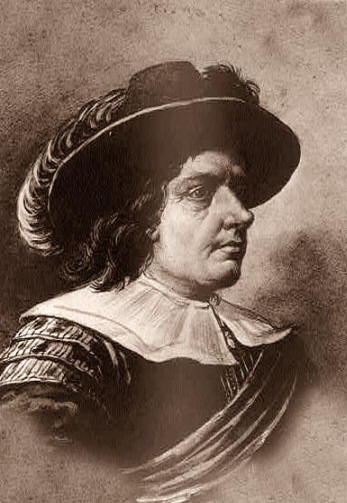William Kieft
|
|
This Site:
|
A more liberal policy in respect to the ownership of land caused the immigration to increase, and Cavaliers from Virginia and Puritans from New England were seen listening to Dominie Bogardus in his fine pulpit in the new church. All that Kieft required of new settlers was an oath of fidelity and allegiance to the States-General of Holland. The demands for new homesteads caused Kieft to purchase lower Westchester and a large portion of Long Island. The encroaching Puritans on the east, and the Swedes on the Delaware, gave Kieft much concern, especially the latter, for Minuit, a former Dutch governor, was at their head. Kieft protested against their "intrusion." Minuit laughed at him, and disregarded his threats. Very soon the energetic character of the governor, manifested in well-doing, was as conspicuous in ill-doing. He allowed his fellow-traders with the Indians to stupefy them with rum and cheat them; and he demanded tribute of furs, corn, and wampum from the tribes around Manhattan. They paid the tribute, but cursed the tyrant. Kieft saw their power and was afraid. Some swine were stolen from colonists on Staten Island, when Kieft, seeking an excuse for striking terror to the hearts of those he had wronged, accused the Raritans of the crime, and sent armed men to chastise them. The River Indians grasped their hatchets and refused to pay tribute any longer. The hatred of all the natives was aroused. The people of New Amsterdam were alarmed, and quarrels between them and the governor were frequent and stormy. He wanted to make war on the Indians. The people refused to bear a musket or favor the crime. Unwilling to bear the responsibility, Kieft called an assembly of " masters and heads of families," in New Amsterdam, to consult upon public measures. Twelve discreet men were chosen (1641) to act for them; and this was the first representative assembly in New Netherland. War was deferred, and the twelve devised a plan for a municipal government for New Amsterdam. Kieft was alarmed, for he did not wish his own power abridged, and he made promises (but to be broken) of concessions of popular freedom on their giving him consent to chastise the Indians in Westchester. It was reluctantly given, when the perfidious governor dissolved them, and forbade any popular assembly thereafter. In 1643 he caused a cruel massacre of fugitive Indians at HOBOKEN. A fierce war was kindled. The friendly Long Island tribes joined their injured brethren, and the Dutch colony was threatened with destruction. Help came from a Puritan, and the Indians were subdued. Kieft, despised by the colonists on whom he had brought ruin, humbly asked them to form a representative council again. The people gladly did so, for they had lost all confidence in the governor. This concession was a pitiful trick of Kieft to foil the wrath of the colonists. He neglected the advice of the popular assembly, and sought by every means to fill his own coffers with gain against a day of reckoning which he perceived was near. The representatives of the people, finding his rule unendurable, asked for the recall of Kieft before the colony should be ruined. Their prayer was heeded, and the people celebrated his departure by the firing of great guns. Some pugnacious burghers threatened the governor with personal chastisement when he should " take off the coat with which he was bedecked by the lords, his masters." The prophecy of De Vries (1643) " The murders in which you [Kieft] have shed so much innocent blood will yet be avenged upon your own head " was fulfilled. Kieft sailed for Holland Aug. 16, 1647, in the ship Princess, with more than $100,000 of ill-gotten wealth. The vessel, by mistake, entered the Bristol channel, struck a rock, and was wrecked on the coast of Wales, and Kieft was drowned. |
|
|
||
|
|
Site Copyright 2003-2018 Son of the South. For Questions or comments about this collection, contact: paul@sonofthesouth.net |
|
|
Are you Scared and Confused? Read My Snake Story, a story of hope and encouragement, to help you face your fears. |
||
 Kieft,
WILHELM, Dutch governor ; born in Holland, about 1600.
Little is known of him before his appearance at Manhattan on March
28, 1638. He seems to have been an unpopular dweller at Rochelle,
France, where his effigy had been hung upon a gallows. De Vries, an
active mariner, who knew him well, ranked him among the "great
rascals of his age." He was energetic, spiteful, and rapacious; the
reverse of Van Twiller, his immediate predecessor. Kieft began his
administration by concentrating all executive power in his own
hands; and he and his council possessed such dignity, in their own
estimation, that it became a high crime to appeal from their
decision. He found public affairs in the capital of
Kieft,
WILHELM, Dutch governor ; born in Holland, about 1600.
Little is known of him before his appearance at Manhattan on March
28, 1638. He seems to have been an unpopular dweller at Rochelle,
France, where his effigy had been hung upon a gallows. De Vries, an
active mariner, who knew him well, ranked him among the "great
rascals of his age." He was energetic, spiteful, and rapacious; the
reverse of Van Twiller, his immediate predecessor. Kieft began his
administration by concentrating all executive power in his own
hands; and he and his council possessed such dignity, in their own
estimation, that it became a high crime to appeal from their
decision. He found public affairs in the capital of